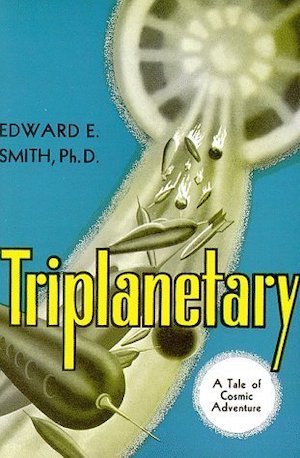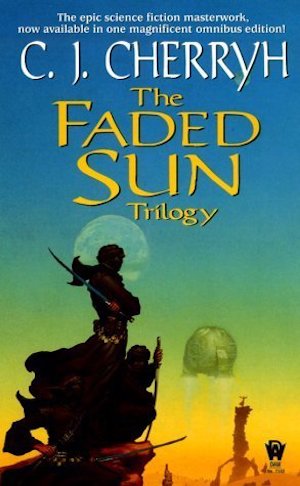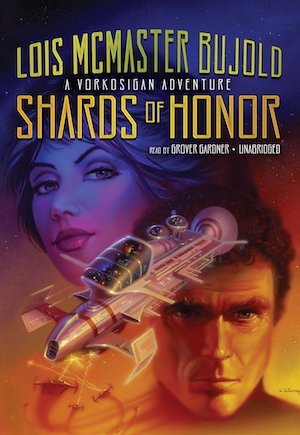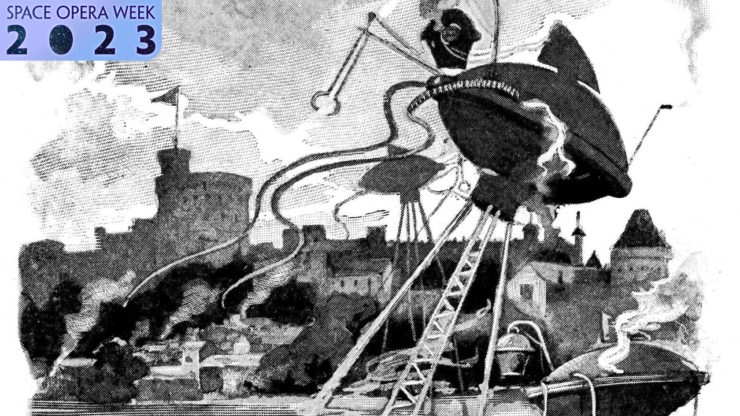There cannot be many heads of state who have not looked at maps and wondered if these were the best borders possible. Nations as vast as Canada could always be a bit vaster (here a Detroit, there a Maine). This applies to space empires as well: even a polity that spans a considerable fraction of the galaxy might believe it deserves to be even larger.
Such expansion is often unwelcome and resisted with force by governments and citizens alike. When SF authors write about wars of conquest and the resistance thereunto on galactic scales, the resulting works are generally considered to be part of the space opera genre. If by some odd chance you have not read any such space operas, you might want to sample the following five classics…
The Lensmen Series by Edward E. “Doc” Smith

Comprised of six novels—Triplanetary (1948), First Lensman (1950) Galactic Patrol (1950), Gray Lensman (1951), Second Stage Lensmen (1953), and Children of the Lens (1954)—the Lensman series pits Arisians against Eddorians. Of equal antiquity, the two sides are polar opposites. The Arisians are paragons of cosmic virtue, while the Eddorians value only power and cruelty. They are all-round poor neighbors. The Arisians are aware of the Eddorians, but Eddorians have no idea that the Arisians exist.
Direct war would result in mutual extermination. The Arisians therefore set in motion a billion-year breeding program. Across the two populated galaxies, eugenically cultivated civilizations rise, then merge into one Civilization. To Eddore, Civilization looks like prey. As the rapidly escalating war that ensues proves, Eddorians have made a terrible, and ultimately fatal, miscalculation.
If you’ve ever set down a book and thought, “Well, it’s nice that Elizabeth and Darcy finally married, but couldn’t Miss Austen have included some coruscating beams of unfathomable power or at least one planetary-scale apocalypse?” Doc Smith has your back. The Lensman books start the cosmic conflict at 11, then rapidly escalate from there.
The Star Fox by Poul Anderson (1965)

Ancient Aleriona has a simple dream. It would like humanity to get off its lawn. Human expansion into galactic space is an unforgivable affront to Aleriona. The aliens start things off by annexing a single human colony world, New Europe.
Every journey begins with a single step.
Earth having only narrowly escaped nuclear self-destruction, pacifism is the governing ethos. Believing that all the colonists died in the alien attack, Earth will not start a war of vengeance. Gunnar Heim, on the other hand, not only has good reason to believe that there are survivors in New Europe, he has the personal resources to fund a private military expedition…if the governments of Earth do not find some way to stop him.
Readers of a certain age might think this book is really about the Vietnam War. In fact, it is totally about the Vietnam War. It argues that misguided pacifism is an ongoing existential threat! Anderson was famously one of the authors who signed one of the dueling petitions in Galaxy. Note which side of the petition he signed.
Readers too young to remember the Vietnam War1 may focus instead on the same detail that bothered me as a teen. While it is perfectly reasonable to expect that the star ship at the centre of a novel called The Star Fox would be called Star Fox, the ship is actually called Fox II. There was a starship called the Star Fox, but it does not appear in this book (or as far as I know, any other book by Anderson).
The Faded Sun Trilogy by C. J. Cherryh (1978–1979)

The trilogy—originally published as The Faded Sun: Kesrith (1978), The Faded Sun: Shon’jir (1978), and The Faded Sun: Kutath (1979)—begins as a dream of conquest dies. The alien Regul, having lost a bid to annex human-controlled worlds, take their frustrations out on their mercenary hirelings. Rather than allow the warlike mri to switch alliances and work for the Federation (something the mri do not appear to be considering), the Regul decide it would be more prudent to simply exterminate the thirteen surviving mri.
This scheme does not end well. Eleven mri die, but Niun and his sister Melein escape the slaughter. Worse from the Regul perspective, the two mri and their human ally Sten Duncan are allowed to flee into deepest space, armed with an ancient star map. The Regul didn’t get where they are by letting well enough alone: a fleet sets out to erase evidence of an embarrassing moment in Regul history. It’s a bold decision that provides many learning experiences.2
I have read suggestions that this series was Cherryh’s response on Dune’s take on interstellar conquest. I don’t know if that is true, but it’s certainly plausible and an interesting way to look at the series.
Shards of Honor by Lois McMaster Bujold (1986)

Venturing through a newly discovered wormhole, Betan scouts discover a habitable world new to Beta. Close on the heels of that revelation, the Betans learn that rival power Barrayar has already claimed the new world and does not desire Betan tourists. In the violence that follows, most of the surviving Betans flee into space while Cordelia Naismith is taken prisoner.
Centuries of isolation followed by an attempted conquest by galactic imperialists have left the Barrayarans an abrasive lot. Nevertheless, what’s true of a planetary population as a whole is not necessarily true of individuals. Cordelia finds much to admire in Aral Vorkosigan and he in her. Cue an interplanetary romance! One that could not be more badly timed, as a sociopath, Crown Prince Serg, leads Barrayar towards an ill-considered war.
I’d like to say that Crown Prince Serg is an exceptional case by which the Barrayaran system of government should not be judged, except that other works in the series suggest that people like Serg are not as rare as one would hope. Barrayar’s culture favours overconfident authoritarians. On the plus side, this tendency means that there’s ample room for political reform, as it’s hard to do worse than Serg.
Consider Phlebas by Iain M. Banks (1987)

The Culture is a star-spanning anarchy run by super-intelligent Minds, seducing hapless alien civilizations with promises of individual freedom and consequence-free hedonism (promises that the Minds keep). Among those brave visionaries who resist the Culture, the Idirans. The Idirans prefer repressive religion, entrenched bigotry, and relentless war on those who disagree. The Culture is a loathed enemy.
Shapeshifter Horza is certain that artificial intelligences such as the Minds are the enemy of real life. The Idirans may be loathsome, but they are alive. Therefore, Horza allied with the Idirans. This is terribly convenient for the Idirans: they can use Horza to collect a Mind that has crash-landed on a planet interdicted by powers the Idirans cannot afford to provoke. Horza’s people are allowed access. Therefore, Horza can capture the marooned Mind without provoking the planet’s guardians. That’s the plan, anyway. What happens will be very different.
“Wait,” you ask, “won’t the Idirans inevitably turn on Horza’s people for the crime of not being Idiran? Isn’t it exceedingly stupid for any non-Idiran to ally with the Idirans?” That may seem at first glance to be the case but on closer examination…the Idirans will do exactly that, given a chance. In Horza’s defense, he makes terrible life choices.
***
Space opera being popular and military SF equally so, it is no surprise these five works about cosmic aggression are a very small sample of a very large field. No doubt many of you have favourites that are not mentioned above. If so, comments are, as ever, below.
In the words of fanfiction author Musty181, four-time Hugo finalist, prolific book reviewer, and perennial Darwin Award nominee James Davis Nicoll “looks like a default mii with glasses.” His work has appeared in Interzone, Publishers Weekly and Romantic Times as well as on his own websites, James Nicoll Reviews (where he is assisted by editor Karen Lofstrom and web person Adrienne L. Travis) and the 2021 and 2022 Aurora Award finalist Young People Read Old SFF (where he is assisted by web person Adrienne L. Travis). His Patreon can be found here.
[1]If you want to learn about contemporary attitudes toward the Vietnam War, perhaps you could read some of the “Doonesbury” comics published during that conflict.
[2]To be fair to the Regul, the Regul aren’t unified and one cannot judge them all by the sad examples who are running things near the human realm. Those sad examples, however, have raised the art of being a bad boss to a very high degree. This will no doubt work out well for them in the long run.












That’s guilty! Guilty, guilty, guilty!
I don’t know about the Dune biz, but I think Cherryh said once that she took the three caste system of the mri from George’s Dumézil.
(Similarly I do not know if Cyteen was a response to Brave New World, but Cherryh once told me that she hadn’t read the latter.)
I find the Battle with the Chlorans in Skylark Duquesne to be right up there in terms of massive destruction.
Lensman Spoiler Alert!
IIRC, the Arisians believe the Arisia vs. Eddore war would have ended up with the Eddorians winning. At any point before the events in Children of the Lens, the Arisians could have wiped out all of the Eddorians except for the top echelon in their fortress. Failing to wipe them out would have meant the Eddorians would have realized the Arisians existed and were a threat, and they would then have been able to create a counter to the Arisians, probably finally forcing them out of their home space.
There’s a seventh Lensmen book, though it’s not part of the main story.
https://en.wikipedia.org/wiki/The_Vortex_Blaster
wrt Fox the first, ISTR that Heim is something of a retired hero rather than a rank amateur given a privateering commission; back when publishers were fine with ~60,000 words in a book, Anderson didn’t need to give us a backstory dump to bulk up to doorstopper size. Or possibly I’m misremembering and the original Fox was sailboat — it has been long and long since I read that screed.
wrt Consider Phlebas, people who like to poke around in literature are warned by the title (derived from Eliot’s “The Waste Land”) that it will end badly. Banks did a sort-of-sequel under the related title Look to Windward.
Two of my old favorites:
In Niven’s Known Space books, the Kzinti are expansionist warmongers who tend to attack a bit early. They’ve got several subject races, but humanity defeats them multiple times.
The buggers, sorry, the Formics in Orson Scott Card’s Enderverse, are imperialist expansionists, who, again, humanity defeats twice: first to get them out of the solar system, later to chase them to their home system.
I mentioned M C A Hogarth’s Peltedverse books in a comment on Judith Tarr’s post, but they belong here too. A species called the Chatcaavans, who are dragon shapeshifters with a highly violent culture, have a couple of political branches. Over the course of the series, one of the branches becomes allies to the Good Guys and somewhat less expansionist and violent, while the other branch becomes even more expansionist and is happy to demolish planets on the way to the larger playing field they think they deserve.
Yoon Ha Lee Machineries of Empire.
Do you necessarily know that a shapeshifter isn’t of the same species as you, if they don’t want to admit it?
Speaking of such, I now don’t know if it’s in TV shows like “The Invaders” and “UFO” and “First Wave” – and I’ll throw in “The Tripods” – that the scientifically superior alien invaders are limited by the economics of space war, so that just stomping us doesn’t work for them and if we are troublesome enough then they actually will give up, being over budget for the conquest. (The only way we could win, realistically.) And we may get to see the alien commander worrying about it. “First Wave” season one did conclude with an alien board meeting. In “UFO” it was Earth’s defence budget that was argued about a lot.
I also want to mention “The Stainless Steel Rat’s Revenge” in which setting space conquest (instead of destruction) is always uneconomic until now for some reason… which is the point of the book. But millennials may find it triggering on many pages. I’ve decided to interpret Rat as a full sociopath, which maybe I was meant to notice in the first place. Well, his first book has a scene where he mind-drugs himself into the poor mental state of his opponent, which may have distracted me from him being screwy the rest of the time too.
David Zindell A Requiem for Homo Sapiens.
One of the earliest books of this type – possibly the first to depict a war fought in space, rather than a space travel being used to get to a planet-based war – was The Struggle for Empire by Robert W. Cole (1900) which had a war fought between the “Anglo-Saxon Empire” of Earth and an unnamed Syrian empire, both roughly technologically equal, which results in wholesale destruction and near-extinction of the human race – the aliens end up losing the war but I suspect winning the peace because the war wasn’t fought in their territory. The motive on both sides is primarily greed, and almost the entirety of vast space fleets pay the price for it. Not exactly a great work of literature – there’s reason to think the publisher was at least in part a vanity press – but a good example of how repellent the motives for war can be.
I spent a lot of time trying to base a role playing game on it around 2009-13 and got nowhere because I have very little sympathy for any of the characters or their motives. As part of that I did end up creating a free ebook of the text which is on line on my web site in PDF and ePub versions:
https://forgottenfutures.co.uk/struggle/struggle.pdf
https://forgottenfutures.co.uk/struggle/struggle.epub
There’s also a speech which I gave about this book and its place in the history of military SF here
https://forgottenfutures.co.uk/struggle/Victorian%20and%20Edwardian%20Military%20SF.pdf
Poul Anderson’s War of Two Worlds involved the conquest of Earth by Mars, the war being orchestrated by a hidden third party.
Early Anderson, before he realized how unlikely Martians are.
Harry Turtledove had an amusing short story (“The Road Not Taken”) where the expanding alien empire happens upon Earth and decides to invade, only to discover that while Earth somehow failed to discover the magical gravity manipulation technology that allows FTL travel, it does have technology more advanced than the matchlock gunpowder weapons that are the height of the aliens’ non-FTL tech.
If you want to see a very current story of warmongering, then check out DC Comics’s Flash right now. Starting with issue #790 (which came out last month), there is a story called The One Minute War, in which an invading extraterrestrial force attacks earth in order to enslave / use up our resources to expand their empire. The invading force (called The Fraction) uses super-speed taken from the Speed Force to quickly take over a planet. The speedsters of earth are aware of the invasion and the entire plot takes place in the span of one minute. The first two parts (and a special tie in) have already been released, with the next installment due out tomorrow (the book is being released every two weeks for this story event). The special fills in the gaps on the Fraction, providing their motivation and backstory. It’s been quite entertaining so far.
Stephen Baxter’s “Xeelee” sequence features a ruthless, imperialistic, genocidal species determined to become top dog in the known universe, and to wipe out any and all other sentient species that may pose a threat to that aim. That species of course is Humanity. I occasionally wonder how long the average reader coming to the series takes to experience the “Wait – we’re the baddies?” flash of insight.
Of course the kicker is that for all of humankind’s efforts, we’re still no more than a mosquito buzzing an elephant against the Xeelee, and in the end they take pity and save our species from extinction.
(One educational aspect of the series – Baxter frequently describes the Xeelee ships as shaped like sycamore seeds. Living in a country where the sycamore tree is basically non-existent, I had to look this up, and found the design and purpose of the seeds quite fascinating.)
The Berserker series by Fred Saberhagen. Likely the inspiration for the Cylons. And the Warp Marine series by C.J. Carella are both excellent entries in the genre.
@@@@@9. Robert Carnegie
It’s been a few decades since I read the Stainless Steel Rat books (they were aging poorly by the mid-80s), but as I recall the Rat and his wife were both explicitly sociopaths, and in her case violently insane, before getting caught and receiving sufficient treatment to be a benefit to society rather than a threat
@13: How did Turtledove justify that? I remember a Christopher Anvil story from ~60 years ago in which alien invaders were baffled by Earthly machine guns; not even having flintlocks is several steps more improbable. (I don’t know why I read this as it was a classic Astoundingly-stupid-aliens-beaten-by-Earth story; I may have picked up the bound magazine original because of a cite in Frank Kelly Freas: The Art of Science Fiction — it’s the sort of story he illustrated a lot of.)
Invasions of Earth (as opposed to battles in space) have more than enough examples to make a column. A couple of old works that quickly come to mind are Sleeping Planet (aliens use a natural knockout gas that only works once, so a few well-traveled humans are awake to attack their superstitions) and World out of Mind (aliens take on human bodies on an Earth where everyone is ranked by tests of ~intellect, but the ones that rank highest defect because Earth is fun and the aliens would make Spock look emotional); neither of these is “classic” except by age, but they don’t creak quite as badly as the Lensman books.
Large-scale space battles are featured in Spinrad’s first novel, The Solarians: human civilization has lost contact with Earth and is being slowly squeezed until a handful of Earthborns show up with new tactics (mostly illogic…). Ellison characterized this as “unreadable”, but I found it small-scale fun.
Arthur C. Clarke’s “Superiority” beautifully inverts the Astounding trope: the narrator explains how too-hasty applications of new technology led to the defeat of an empire that was technologically and economically ahead of Earth’s dominions before the war started: a first version of Second Stage Lensman‘s battle controller Directrix is vulnerable to suicide attacks (leaving a fleet without adequate sub-commanders), a device that stretches space in a way that would allow ships to appear in the heart of an enemy fleet doesn’t un-stretch symmetrically….
@18 – As I remember, it turned out that the discoveries of antigravity and FTL were really really easy and that humanity was extremely exceptional in not discovering them. So the murderous teddy bears just spent all their time conquering more and more star systems and not developing any new tech.
I’ll see your Lensman and raise you Skylark!
In the Skylark series our heroes started with a little conflict with a single planet and one little spaceship. By the last book we were talking intergalactic war, species extermination, and Richard Seaton having to take off his headset so that he wouldn’t blast Blackie Duquesne into interstellar dust with a single angry thought.
BTW is Duquesne the only space opera villain who not only gets to rule a galaxy but also gets the girl and both are considered happy endings?
@13 Turtledove expanded on the concept in his “Worldwar” series of novels (a tetralogy + trilogy), in which reptilian aliens attempt conquest of Earth in December 1941. Although they have interstellar travel, their weaponry is only a slightly advanced version of what was then available to Earth’s armies. The Axis and Allies are forced to somehow find common cause to fight the invasion, and many are caught between sides.
‘I also want to mention “The Stainless Steel Rat’s Revenge” in which setting space conquest (instead of destruction) is always uneconomic until now for some reason… which is the point of the book. But millennials may find it triggering on many pages. I’ve decided to interpret Rat as a full sociopath,’
No, Jim definitely is _not_ a sociopath, as such. He values human life, and goes out of his way and makes difficulties for himself as a result of that value. He _does_ have a seriously screwed up value system, but he’s capable of empathy and emotional connection. His wife is a sadist and a sociopathic murderess before the government brainwashes her into being more like Jim (though still nastier).
As for why interstellar conquest doesn’t pay, it’s because of the background tech that the author assumed to produce just that result: it just costs too much to be profitable most of the time, except in special case situations.
@20: There’s a 1980s book series in which the bad guy kills a billion people or so, reforms and gets both the girl and to rule the galaxy : (rot13 for spoilers): Gur Fntn bs gur Cyvbprar Rkvyr frevrf ol Whyvna Znl
(edited to correct my error)
@23 – also works in ROT-18 for some reason.
Let’s not forget Poul Anderson’s “The High Crusade”, in which the star-spanning Wersgorix Empire tries to conquer a medieval English town. Bad move.
@18 chip137: omg, World out of Mind ! Haven’t read that in a zillion years. I don’t know how it would hold up now, but I loved it when I was a kid back in, uh, the Jurassic…
I assure you that the Berserkers were in no way the inspiration for the Cylons. What inspired the Cylons was the limitations of Battlestar Galactica’s budget for alien makeup. Turning all the Cylons into robots was just cheaper than going with the original lizardmen concept although they also wanted enemies who don’t “really” die for the lizardmen’s disposable mooks. Battlestar Galactica (the original) was incidentally written with the same slant that The Star Fox and Starship Troopers, similarly motivated by outrage at detente with the Soviet Union.
Legend of Galactic Heroes is an interesting series of Japanese science fiction novels featuring two genius military leaders representing the two similarly contemptible interstellar nations that dominate the galaxy, a racist autocracy and a crumbling corrupt democracy.
@18: Spoilers for “The Krugg Syndrome” (1988). From memory.
A young Scotsman in 1965 wakes up in an asylum knowing that he is a soldier of the Krugg, an alien race of immobile trees with the mental power to control animal life, whose invasion ship is parked in polar orbit. However, in possessing a human victim, he has lost the mental power.
He carries on with human life, working at an old fashioned law firm in Glasgow, waiting to be contacted.
We are reading his journal.
Reading between the lines, being a tree isn’t much fun, and the Krugg aren’t very intelligent (nor very nice). If not for the mind control, they’d be decking. And they may be imaginary.
T.H.E.M. by G.C. Edmondson (Theriomorphic Hellbent Enemy Mission)
THE HIGH CRUSADE
BILL, THE GALACTIC HERO
THE FORGE OF GOD/ANVIL OF STARS